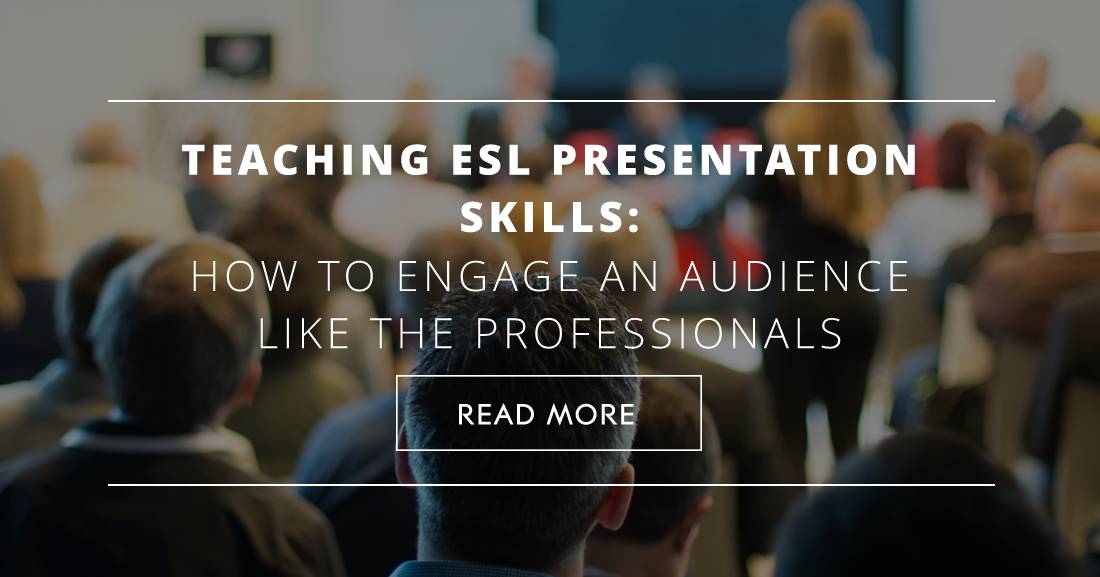Teaching ESL Presentation Skills: How to Engage an Audience like the Professionals


As an ESL specialist, I often require my students to gather their thoughts into the form of a presentation and deliver this information to the class. This is a challenging format, and it requires extensive preparation and rehearsal, all of which helps hone language skills and builds confidence.
Passion, however, is seldom enough. We need to help our students to craft their message into a neat, readily comprehensible structure, and doing so can make the difference between ten minutes of drudgery, and ten minutes which might actually change some lives. The secret is to prepare the content carefully in advance, to partition it sensibly, to rehearse its delivery, and to bear in mind - at all times - the probable reactions and experiences of the audience.
Here are some tips for helping your students to properly structure their presentations:
Sit with your eyes closed for a moment and bring to mind a topic you wouldn’t mind being educated about for the next ten minutes - coral reefs or interstellar travel would be right up my street, for instance - and imagine how the presentation would begin. It’s unlikely to be something like, “Good morning. I want to tell you about the bleaching of coral reefs off Australia.” Instead, I teach my students to begin their structure by reaching out and grabbing their audience’s attention with both hands:
What do your students want their audiences to think, during those crucial opening moments? Tailor the content to fit those anticipated reactions. Personally, I’d love if the audience thought…
It’s not simply an ADD symptom to want to hear someone’s presentation fall into manageable chunks. The mind appreciates this, and each new section forms a mini fresh-start within the flow of the material. For me, the best presentations by teenage ESL students feel a little like I’m listening to a suite of music, with distinct forms and styles which are inherently connected to each other, but separated by natural pauses.
Here are some ways to divide your presentation and give your audience a quick mental break:
Next time you’ve got a few spare moments, put on a famous piece of classical music - Mozart’s Eine Kleine Nachtmusik or one of Bach’s Brandenburg Concertos, perhaps. Once you’ve enjoyed that, try something completely different and put on a piece of Karlheinz Stockhausen or Luciano Berio. The biggest differences between these pieces are that, with Mozart, you know where you are! There’s a beginning, a middle and an end, because he uses themes which recur and provide an overarching structure. There’s a sense of, “Yeah, hey, I’ve heard this before. We’re home again’, but with modern music, there are no such anchors or waypoints.
Listening to a presentation, like listening to music, is physically easier when the content is explicitly organized and includes neat, repetitious motifs which give us a sense of structure. Use a recurring joke, a little self-deprecation, a repeating image, a gesture you establish at the outset and repeat for a particular meaning, or any other method to inject obvious reinforcement into the structure of the presentation.
Some of the most popular and successful presentations in the world are the TED Talks. If you haven’t sampled these, you’re about to encounter a universe of knowledge, most of it engaging relayed by highly gifted speakers. Many TED talks finish with a call to action, or some kind of advice or request which the audience can take forward into their everyday lives. I’d want to make sure that my audience becomes aware of how they can voice their horror at coral bleaching, become involved in advocacy, contribute to a charity, and educate on the topic. Leave your audience with a question to think about: “Can you imagine a world without coral?” or a plea for their intervention: “Without action by you and me, the reefs are going to die. What can you, as an individual, do about it?”
It’s just polite, but also it reinforces your gratitude that they’ve given ten minutes of their lives to you and the things you want to say. With luck, it was an enjoyable ten minutes, and being thanked for their attention makes an audience feel, somehow, as though they themselves contributed to the success of the talk. They become stakeholders, not only passive observers, and that can make all the difference.
Exactly how is hard to pin down, but there’s a certain air of competence and security we feel when we know where we are in a given structure, and can anticipate the remainder. In some ways, Mozart’s music sounds like that of a genius because we’re seldom lost, and experienced listeners can pin-point precisely where they are in Mozart’s traditional structures. Have your students think carefully about the perception of their audience, make sure their topic is broken into (relatively) bite-sized pieces, and rehearse rigorously until they have found just the best way to structure the talk. They shouldn’t be afraid of having to re-draft the presentation, as doing so almost guarantees that it will be more successful and memorable for the audience.